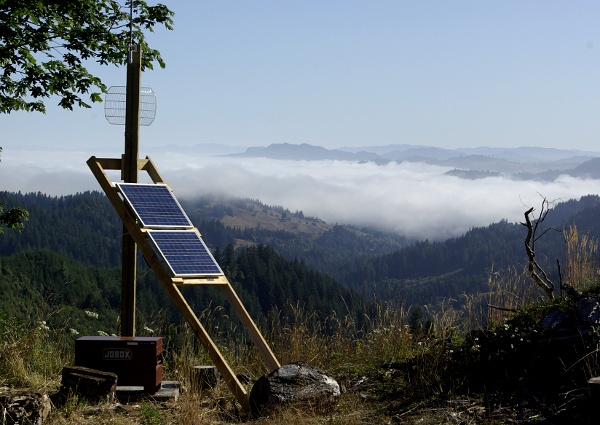
Our Solar-Powered Radio Internet Connection
On June 28, 2011, my internet service provider (ISP) went out of business. One minute I was surfing the web at about 1.5 Mbps (megabits per second – a fairly fast internet speed — at least it was fast enough to get work done online) and the next minute they were gone. The owner and the only technical brains of that local ISP (Rural Access Internet Company = RAIC) Guy Ralph, died in January of this year. He was a great guy, and had a vision to help people like us, who live in rural areas where we will never, ever, ever get DSL or Cable or Fios or any other fast connections to the web, through regular ISPs, because it just doesn’t make sense for them to spend hundreds of thousands, or millions of dollars on equipment to service a very few people. After his untimely death, his wife decided that the company he created wasn’t worth continuing, and left their 120 or so customers — all like us, out in the sticks — high and dry. I am trying not to sound bitter; it’s hard.
RAIC had set up internet via 900 Mhz radio equipment which we were lucky enough to be able to see by line of sight from the top of our house, through a gap in the hills surrounding our home office, about five years ago. We have been very dependent on RAIC for our livelihood.
So as of June 28, we were on our backup dialup connection to the web, through Earthlink.
We were unwilling to go with Hughes.net — it just won’t work for us. Hughes.net satellite service basically, well, it sucks. It is expensive, you get very limited (“throttled”) bandwidth, and very slow even at the best of times. We snicker when we see their ads on TV for “blazingly fast downloads” — it’s a total lie. We usually burn through more bandwidth in an hour than they will let you have in 24 hours. After you burn through your bandwidth, they don’t shut you off completely, they just slow it down to dialup speeds.
3G service is not available to our home/office — we have no cell reception at our place, because we are down in a bowl, surrounded by hills.
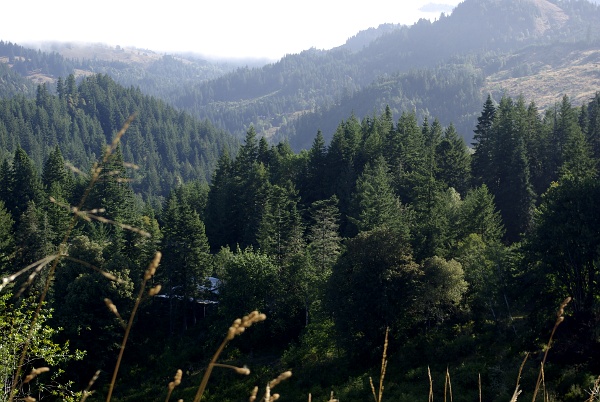
Our house seen from the landing.
I tried contacting the company that had been providing RAIC with its fiber optic connection to the web, and seeing what they had to offer. Although they were optimistic about getting us a T1 line — which uses two pairs of regular phone lines to deliver quite a bit of bandwidth — they wanted $500 to install, and $500/month to maintain! Plus whatever Frontier would charge to put in the equipment. Expensive, yes, but if it was the only option, we would be forced to go that way. They proceeded to try to get Frontier (our local phone company) to install the equipment. Six weeks later, it was obvious that Frontier was never even going to tell us what it would cost to install a T1 line to our location, 8 miles out a dirt road and 14 miles from town (10 as the crow flies).
So we cancelled all plans for a T1 line.
A few weeks ago, David Grimes called me. We knew each other because he also does highly technical things locally and he had tackled a server project for us some years back. Dave handles server setup and security for quite a few clients in South Coastal Oregon. He is an excellent, knowledgeable technician who gets things done. He said that we were both in the same boat — he’d been a customer of RAIC and was now offline. We agreed it was an intolerable situation and that we had to handle it or we’d be out of business. He said he would be setting up modern radio equipment, something similar to what RAIC had had, but more reliable. But he didn’t plan on using that radio tower (the one visible from the top of our house) because it was expensive and unnecessary to lease space for our radios on that radio tower. We could go around them.
Dave is also a ham radio person with a deep understanding of how radios work and how computer networks work.
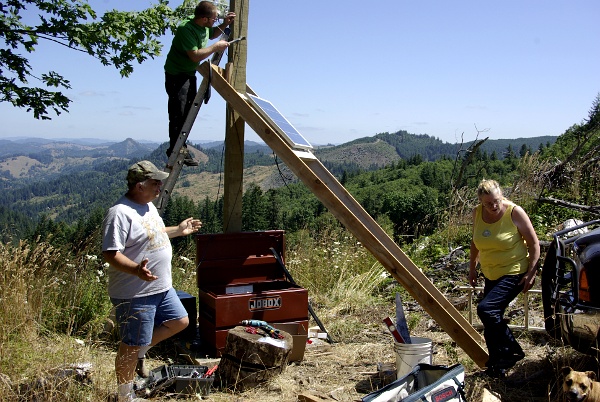
Dave Grimes, Dennis, and Marie
(and Sadie the Dog)
Installing Solar Panels and Radios
First he had to connect to the backbone — so he leased a 50Mbps fiber-optic line from Charter — which ends at an office in Myrtle Point. From there, he set up a radio installation using Ubiquity radios to get the signal over to a house on the south end of Myrtle point (which he can see from his office in Broadbent).
So he got his own connection to the net working a couple of weeks ago.
Immediately after that, he set up a local public Wifi for Broadbent. I helped him set up a 5.8 Ghz radio and a huge Wifi hotspot with a 30 mile line-of-sight radius, to service the Broadbent area.
The bad news is that from our house, 14 miles from Myrtle Point, and down in a bowl, we get no signal from any of those radios. However, from the landing (a flat space the loggers created when they logged this area many years ago) on the top of the hill behind our house, there’s plenty of signal — with a good pair of field glasses, you can SEE that house at the south end of in Myrtle Point, from our landing. And the 5.8 Ghz radio signal coming from that house at the south end of Myrtle Point is strong and clear.
So — how to get us signal down in our bowl? Set up a radio relay on our landing.
But there’s no power up on that landing. It was a big, but not insurmountable problem.
In the meantime it has been nearly impossible to get any web development work done over dialup. My partner Marie moved her computer to a little office in Myrtle Point so she could do actual web development for some of our clients using a connection through a Comcast connection, at about 3 Mbps.
Since you can see our house, our neighbors, and our daughter’s house from that landing, it seemed like a good location to set up a relay that would offer them internet service as well. We had to provide POWER to the landing.
We planned out a solar system and I started purchasing equipment.
Since the radios would run on 24 volt DC, we needed to have a solar/battery system that would produce 24 volts. The radios only use about half an amp (500 milliamps), total. Although that may vary under an increased load — we’re still not sure about that.
Dave found a provider of solar panels over near Grants Pass — BatteryStuff.com. I drove over (3 hours each way) and bought two 68-watt, 12-volt solar panels and hooked them up in series, so they output 24 volts. (Cost = $852)
We bought a 24-volt controller (Steca PR charge controller) from them as well. Hooking that up proved to be a breeze — we just assembled it, connected it to the batteries, and it started charging them up, with no problems whatsoever, right out of the box.
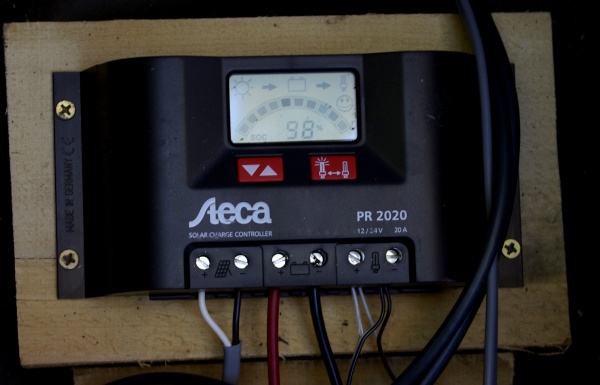
24-volt Steca power controller for solar panels and radios.
The four 6-volt deep-cycle batteries (normally you’d use these in an electric golf cart or similar vehicle) we purchased from Les Schwab, for about $375, and connected them in series, and they output 24 volts no problem.
We needed something weatherproof (we get about 120 inches of rain per year here — another way of putting that is TEN FEET of rain every year) to house the batteries and controller. So we bought a Jobox for $375 — a big metal box you’d use on a construction site to keep your blueprints and tools secure. It locks up good and tight — and I put in weatherstripping so even when the winds blow 100 MPH up on the landing, as they will when we get a good storm going through here, it should keep the water out.
We set up the two radios on a 16-foot pressure-treated six-by-six wood post that we set in a concrete pad up on the landing: one radio is a dish to communicate with the 5.8 Ghz radio mounted on the house at the south end of Myrtle Point, and the other is a “bullet” 2.4 Ghz radio to relay the signal down to our house, to our neighbors, daughter, and so on.
The radios are supplied with “Power Over Ethernet” (POE) converters that are supposed to plug into 110 AC — so we had to figure out how to connect them with our 24-volt power supply. Dave built an Ethernet cable “harness” that should have connected them if they used the standard 8-pin pin-out configuration for power over Ethernet. We plugged it all in — nothing. No lights on the radios to indicate they were receiving power from our batteries through our controller. No nothing. We had to call for tech support — turns out we needed two $8 parts (“power injectors”) to make it work, because the Ubiquity radios do not use standard ethernet cables for their Power over Ethernet devices.
We ordered the last two parts on Wednesday, 8/10/2011, two-day air, from LA. As of Friday, no delivery. Saturday they arrived. But they were mssing a fifty-cent part we couldn’t get until Monday from Radio Shack!
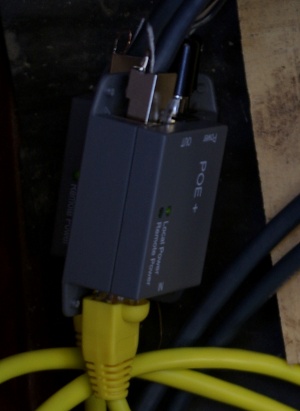
The $8.00 part that stymied us for a week
Finally, on Monday, 15 August 2011, we plugged everything in and got all the equipment set up, routed properly and talking to each other. We now have solar-powered internet! and so does my daughter, two miles away.
Total cost has been about $2200, including the radios. But it’s a one-time expense.
Notes on the solar: It is August now, so we’re getting plenty of sun and the system hasn’t gone below 98% charge since we plugged everything in. I went up the hill this morning and checked the charge on the battery before sunrise — the batteries were at 98% charge, after the equipment was running all night with no input from the solar panels. So I think we’re going to be good for those long winter nights, and the gray days of winter and spring. But if need be, we will set up another rank of batteries. There’s plenty of room in the Jobox (the brown box in the photos) which protects all the batteries and controller from the elements. In rural Oregon, it is best not to “leave unattended” anything out in the woods. So our Jobox is locked and bolted down to a concrete pad.
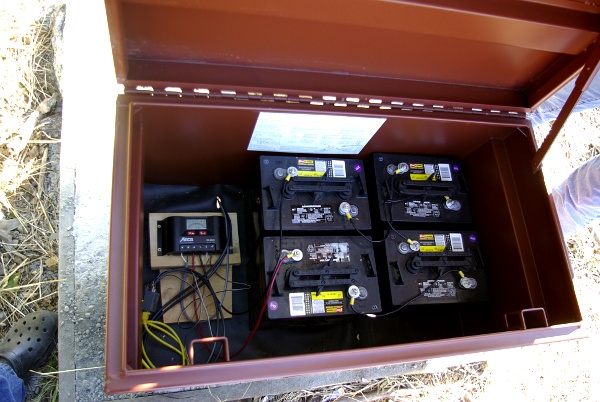
Batteries and Controller Nestled in the Jobox
It is not the prettiest thing I’ve ever built, but it is *strong* to withstand the wind, and fully functional, and we’re getting about 8 Mbps download through it right now — there is some physical bottleneck (throttle) at the relay in Myrtle Point, which will be fixed shortly and we should be able to get about 50Mbps when everything is set up correctly.
Still to do: The mounting of the solar panels will be changed out to a metal frame (instead of cedar 2×6 construction), mounted on hinges, so we can adjust the angle of the solar panels every month. It will be connected at the bottom to posts set in the ground in cement. Right now the bottom of it is being held down by a log! In the winter the best angle will be about 16 degrees from vertical because the sun is so low on the horizon here — we are almost at the 45th parallel. Right now the best angle is at about 35 degrees from vertical, in order to accumulate the most sunshine for this time of year (according to charts Marie looked up on the internet).
Kudos go to David Grimes for figuring out how to make it all work, and being willing to set all this up. He’s a genius when it comes to networking. And radios. Without him it would not have been possible — I wouldn’t have attempted it.
We plan to start offering internet service to neighbors soon — as soon as the public end of our website offering the service is up, so people can place orders without having to call Dave and make his life difficult. Anyone in line-of-sight from our landing can install a “nano” radio, point it up at the landing, and have internet in short order. Or work on Wifi if their signal is strong enough. Marie’s Motorola Xoom can connect directly to the 2.4 Hgz radio on the landing, without going through our own Dlink Wifi hotspot. So can both our laptops, which are wifi enabled. And my Kindle also sees that radio as a possible connection to the web. (It’s password protected, so we’re not connecting to it, but I believe the plan is to make it publicly available shortly, for a small fee, payable right then and there.)
When it was completed, we did a little dance and celebrated with ice cream. The relief of having a connection I can use to work again is palpable!

Congratulations!!!!!!!
Good stuff and super geeky. Thanks for taking the share.
We had to replace the “Bullet” with a “Nano Macro” radio, from Ubiquity, because it blew out about a week after we put it in place.
We had a “Nano” radio on top of our house, but it had significant problems as well. We went with a “Nano Macro” there as well, and now our connection is stable and fast.
What we learned: Don’t use Nano Mini radio from Ubiquity — they burn out or otherwise do not work as advertised. But the Nano Macro is awesome.